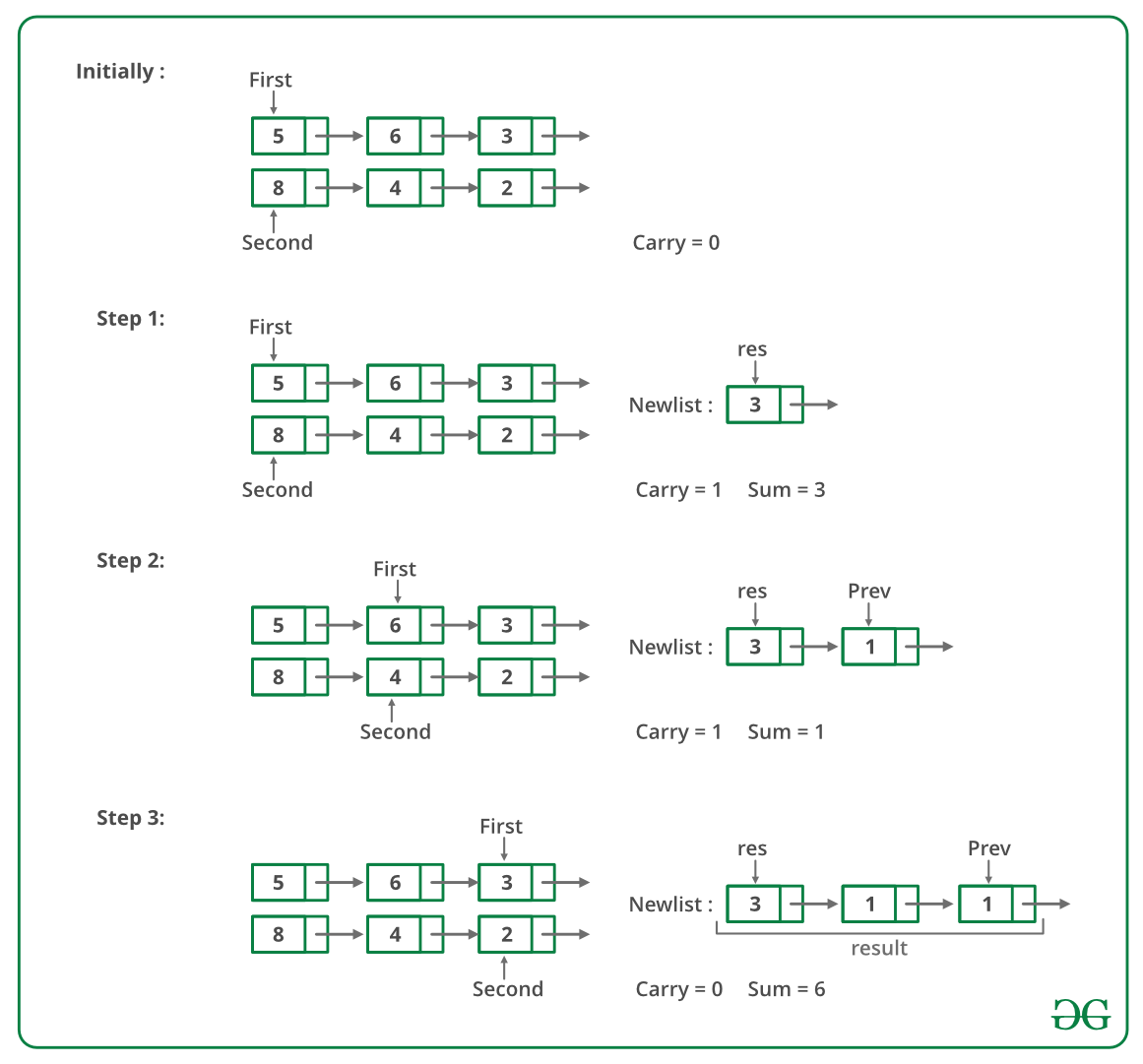用于添加由链表表示的两个数字的 C 程序 - 集 2
给定由两个链表表示的两个数字,编写一个返回和列表的函数。和表是两个输入数相加的链表表示。不允许修改列表。此外,不允许使用显式的额外空间(提示:使用递归)。
示例:
Input:
First List: 5->6->3
Second List: 8->4->2
Output:
Resultant list: 1->4->0->5我们在这里讨论了一个解决方案,它适用于链表,其中最低有效位是列表的第一个节点,最高有效位是最后一个节点。在这个问题中,最高有效节点是第一个节点,最低有效数字是最后一个节点,我们不允许修改列表。这里使用递归来计算从右到左的总和。
以下是步骤。
1)计算给定两个链表的大小。
2)如果大小相同,则使用递归计算总和。将递归调用堆栈中的所有节点保持到最右边的节点,计算最右边的节点的总和并向前进位到左侧。
3)如果大小不一样,请按照以下步骤操作:
…… a)计算两个链表的大小差。让差异变得不同
…… b)在更大的链表中将差异节点向前移动。现在使用步骤 2 计算较大列表的较小列表和右子列表(相同大小)的总和。此外,存储此总和的进位。
…… c)计算进位的总和(在上一步中计算)与更大列表的剩余左子列表。该总和的节点被添加到上一步获得的总和列表的开头。
以下是上述方法的试运行:

下图是上述方法的实现。
C
// A C recursive program to add two
// linked lists
#include
#include
// A linked List Node
struct Node
{
int data;
struct Node* next;
};
typedef struct Node node;
/* A utility function to insert a
node at the beginning of
linked list */
void push(struct Node** head_ref,
int new_data)
{
// Allocate node
struct Node* new_node =
(struct Node*)malloc(sizeof(struct Node));
// Put in the data
new_node->data = new_data;
// Link the old list off the
// new node
new_node->next = (*head_ref);
// Move the head to point to the
// new node
(*head_ref) = new_node;
}
// A utility function to print
// linked list
void printList(struct Node* node)
{
while (node != NULL)
{
printf("%d ", node->data);
node = node->next;
}
printf("n");
}
// A utility function to swap
// two pointers
void swapPointer(Node** a, Node** b)
{
node* t = *a;
*a = *b;
*b = t;
}
/* A utility function to get size
of linked list */
int getSize(struct Node* node)
{
int size = 0;
while (node != NULL)
{
node = node->next;
size++;
}
return size;
}
// Adds two linked lists of same
// size represented by head1
// and head2 and returns head of
// the resultant linked list.
// Carry is propagated while
// returning from the recursion
node* addSameSize(Node* head1,
Node* head2,
int* carry)
{
// Since the function assumes
// linked lists are of same
// size, check any of the two
// head pointers
if (head1 == NULL)
return NULL;
int sum;
// Allocate memory for sum
// node of current two nodes
Node* result =
(Node*)malloc(sizeof(Node));
// Recursively add remaining nodes
// and get the carry
result->next = addSameSize(head1->next,
head2->next, carry);
// Add digits of current nodes
// and propagated carry
sum = head1->data + head2->data + *carry;
*carry = sum / 10;
sum = sum % 10;
// Assigne the sum to current
// node of resultant list
result->data = sum;
return result;
}
// This function is called after
// the smaller list is added
// to the bigger lists's sublist
// of same size. Once the
// right sublist is added, the
// carry must be added toe left
// side of larger list to get
// the final result.
void addCarryToRemaining(Node* head1, Node* cur,
int* carry, Node** result)
{
int sum;
// If diff. number of nodes are
// not traversed, add carry
if (head1 != cur)
{
addCarryToRemaining(head1->next,
cur, carry,
result);
sum = head1->data + *carry;
*carry = sum / 10;
sum %= 10;
// Add this node to the front
// of the result
push(result, sum);
}
}
// The main function that adds two
// linked lists represented
// by head1 and head2. The sum of
// two lists is stored in a
// list referred by result
void addList(Node* head1,
Node* head2,
Node** result)
{
Node* cur;
// first list is empty
if (head1 == NULL)
{
*result = head2;
return;
}
// second list is empty
else if (head2 == NULL)
{
*result = head1;
return;
}
int size1 = getSize(head1);
int size2 = getSize(head2);
int carry = 0;
// Add same size lists
if (size1 == size2)
*result = addSameSize(head1,
head2,
&carry);
else
{
int diff = abs(size1 - size2);
// First list should always be
// larger than second
// list. If not, swap pointers
if (size1 < size2)
swapPointer(&head1, &head2);
// move diff. number of nodes in
// first list
for (cur = head1; diff--;
cur = cur->next);
// Get addition of same size
// lists
*result = addSameSize(cur,
head2,
&carry);
// Get addition of remaining first
// list and carry
addCarryToRemaining(head1, cur,
&carry, result);
}
// If some carry is still there, add
// a new node to the front of the
// result list. e.g. 999 and 87
if (carry)
push(result, carry);
}
// Driver code
int main()
{
Node *head1 = NULL,
*head2 = NULL,
*result = NULL;
int arr1[] = {9, 9, 9};
int arr2[] = {1, 8};
int size1 = (sizeof(arr1) /
sizeof(arr1[0]));
int size2 = (sizeof(arr2) /
sizeof(arr2[0]));
// Create first list as 9->9->9
int i;
for (i = size1 - 1; i >= 0; --i)
push(&head1, arr1[i]);
// Create second list as 1->8
for (i = size2 - 1; i >= 0; --i)
push(&head2, arr2[i]);
addList(head1, head2, &result);
printList(result);
return 0;
} 输出:
1 0 1 7时间复杂度:
O(m+n) 其中 m 和 n 是给定两个链表的大小。
请参考完整的文章添加链表表示的两个数字 |设置2了解更多详情!